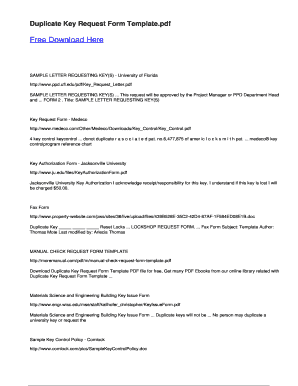Fill and Sign the Sample Authorization Letter to Duplicate Keys Form

Practical advice on finishing your ‘Sample Authorization Letter To Duplicate Keys’ online
Are you fed up with the inconvenience of handling paperwork? Search no further than airSlate SignNow, the leading eSignature solution for individuals and organizations. Bid farewell to the monotonous routine of printing and scanning documents. With airSlate SignNow, you can easily complete and sign documents online. Utilize the extensive features integrated into this user-friendly and affordable platform and transform your approach to document handling. Whether you need to sign forms or gather electronic signatures, airSlate SignNow manages everything effortlessly, with just a few clicks.
Follow this detailed guide:
- Log into your account or sign up for a free trial with our service.
- Click +Create to upload a document from your device, cloud storage, or our template library.
- Open your ‘Sample Authorization Letter To Duplicate Keys’ in the editor.
- Click Me (Fill Out Now) to prepare the document on your side.
- Add and designate fillable fields for others (if needed).
- Proceed with the Send Invite settings to request eSignatures from others.
- Save, print your copy, or convert it into a multi-usable template.
Don't be concerned if you need to work with others on your Sample Authorization Letter To Duplicate Keys or send it for notarization—our solution provides everything necessary to complete such tasks. Create an account with airSlate SignNow today and take your document management to new levels!
FAQs
-
What is a Sample Authorization Letter To Duplicate Keys?
A Sample Authorization Letter To Duplicate Keys is a formal document that allows an individual to grant permission to another person to duplicate keys. This letter typically includes details about the keys and the parties involved, ensuring the process is legally recognized. Using a sample template can simplify the creation of this letter, making it quick and efficient.
-
How can I use airSlate SignNow to create a Sample Authorization Letter To Duplicate Keys?
With airSlate SignNow, you can easily create a Sample Authorization Letter To Duplicate Keys by utilizing our customizable templates. Simply select a relevant template, fill in the necessary details, and eSign the document to ensure its validity. Our platform streamlines the entire process, making it straightforward and efficient.
-
Is there a cost associated with obtaining a Sample Authorization Letter To Duplicate Keys through airSlate SignNow?
airSlate SignNow offers various pricing plans that cater to different business needs, including options for creating a Sample Authorization Letter To Duplicate Keys. While there may be a subscription fee, the service is designed to be cost-effective, providing great value with its features and ease of use.
-
What features does airSlate SignNow offer for creating authorization letters?
airSlate SignNow provides a range of features that facilitate the creation of authorization letters, including drag-and-drop document editing, customizable templates, and eSignature capabilities. These tools make it easy to generate a Sample Authorization Letter To Duplicate Keys quickly and securely, ensuring that all necessary information is included.
-
Can I integrate airSlate SignNow with other applications for managing authorization letters?
Yes, airSlate SignNow seamlessly integrates with various applications, enhancing your ability to manage documents like a Sample Authorization Letter To Duplicate Keys. Whether you use CRM systems, cloud storage, or other business tools, our integration capabilities ensure your workflow remains efficient and connected.
-
What are the benefits of using airSlate SignNow for authorization letters?
Using airSlate SignNow for your authorization letters, such as a Sample Authorization Letter To Duplicate Keys, offers numerous benefits including ease of use, fast turnaround times, and legally binding eSignatures. This not only saves time but also simplifies the process of document management, making it ideal for busy professionals.
-
How secure is the information in my Sample Authorization Letter To Duplicate Keys when using airSlate SignNow?
Security is a top priority at airSlate SignNow. When creating a Sample Authorization Letter To Duplicate Keys, your information is protected through advanced encryption and secure cloud storage. This ensures that your documents remain confidential and tamper-proof throughout the signing process.
Related searches to sample authorization letter to duplicate keys form
Find out other sample authorization letter to duplicate keys form
- Close deals faster
- Improve productivity
- Delight customers
- Increase revenue
- Save time & money
- Reduce payment cycles

